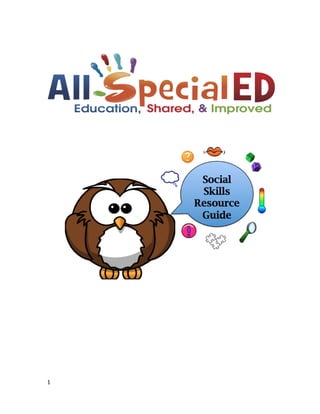
Social Skills Resource Guide: 40+ Strategies for Teaching Social and Emotional Skills
- 1. 1
- 2. Table of Contents Introduction 3 Acknowledgements 4 Disclaimer 5 Social Skills Apps 6 Social Emotional Programs and Related Strategies ● SelfRegulation Scale 8 ● Big Problem/Little Problem Social Skills Programs and Related Strategies 13 ● Playing Board Games ● Asking Questions ● Thought Bubbles Anxiety Resources and Related Strategies 20 ● Coping Cards ● StepLadders Videos for Teaching Social Skills 22 Social and Emotional Books Lists 25 Dedication 26 2
- 3. Introduction The ability to adapt to and negotiate our social environment is more important to one’s success than any subject we learn about in school. Having the skills as therapist, educator, or parent to teach and expand our children’s knowledge of the social world opens a world of opportunity for kids of all ages. To support this vision January’s discussion topic was aimed to increase our understanding of social skills, strategies, programs, and technology. Thanks to your ideas and tips we were able to create The Social Skills Resource Guide. We hope the pages in this book help you pilot new techniques so you can begin to break social barriers. Together we are a powerful learning community, and we can’t wait for our next discussion! Sincerely Yours, Joy & Colleen 3
- 5. Disclaimer This ebook is intended for educational purposes only. AllSpecialED does not receive any monetary gain from the distribution of this ebook. The ideas and materials presented in this ebook originate from members of the AllSpecialED community. AllSpecialED is not responsible for copyright infringements. By contributing to this ebook, members have verified one the following: ● The ideas and materials are original work, ● The original author has provided written consent to share materials, ● Members have provided appropriate citations for adapted content. You may download the content for scientific or educational uses. You may not sell, reproduce, transmit, distribute, perform or display such content for any commercial purpose without the express consent of AllSpecialED. 5
- 17. Conversation Board: For Asking New Topic and Follow Up Questions I use this board for three things: ● To support the concept of Friend Files as developed by Michelle Garcia Winner. ● Question formulation. ● Producing supporting comments. (It should be noted that students have previously been introduced to Friend Files, New Topic Questions, Follow Up Questions, and Supporting Comment Lessons. Please see Think Social, A Social Thinking (R) Curriculum for School Age Students by Michelle Garcia Winner for more information on how to teach these concepts). So…I start by asking students to formulate a new topic question to begin a conversation (or use topic cards), and write that question on top of the board. They then are encouraged to ask 23 follow up questions. If their follow up questions make sense with reference to the conversation then I circle the smiley face to right of the question. If the question doesn't make sense then I circle the confused face to show the child that their question was out of reference (and briefly explain why). They are encouraged (with prompting) to restate the question so it makes sense. As their conversation partner is talking I also prompt the student to make verbal supporting comments by pointing to the comment boxes and circle them as they are mentioned. This visual feedback is a great way for kids to track their progress and become aware of their performance. I have also made a smaller, portable version on a key chain for use during lunch or in the classroom. Enjoy! Here is the link on Boardmaker share: http://www.boardmakershare.com/Activ...ersationBoard I happened to get a calendar from MacNeil Glass in Natick today and it has a 17
- 24. Social and Emotional Books Lists Books That Focus on Emotions Books That Focus On Social Skills 24
- 25. DEDICATION A Special Congratulations! Congratulations to Lois Aginsky, Joy’s mother and ASE member, who has recently been awarded: Teacher of Year in the Bridgeport, CT PSD 25
- 26. Within a large urban district where resources can be scarce and students with needs are plentiful, Lois inspires us with her dedication, drive, and her ability to execute best practices. We are so proud of you and so thankful for your unwavering support of us as we have developed the AllSpecialED community! Thank you and congratulations on this amazing honor! You deserve it! 26